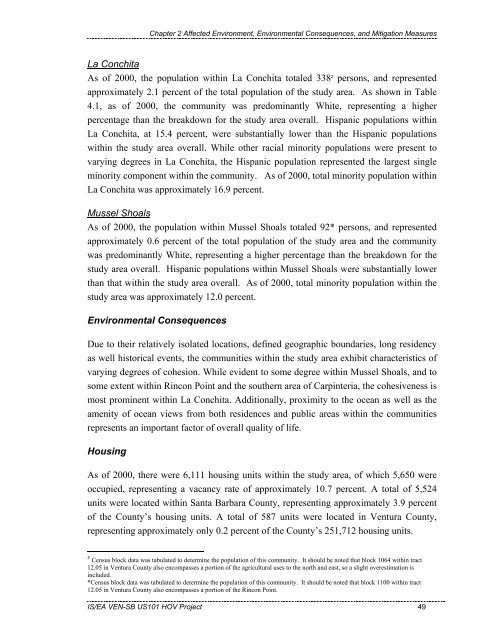Chapter 1 - Caltrans - State of California
Chapter 1 - Caltrans - State of California
Chapter 1 - Caltrans - State of California
Create successful ePaper yourself
Turn your PDF publications into a flip-book with our unique Google optimized e-Paper software.
<strong>Chapter</strong> 2 Affected Environment, Environmental Consequences, and Mitigation Measures<br />
La Conchita<br />
As <strong>of</strong> 2000, the population within La Conchita totaled 338 2 persons, and represented<br />
approximately 2.1 percent <strong>of</strong> the total population <strong>of</strong> the study area. As shown in Table<br />
4.1, as <strong>of</strong> 2000, the community was predominantly White, representing a higher<br />
percentage than the breakdown for the study area overall. Hispanic populations within<br />
La Conchita, at 15.4 percent, were substantially lower than the Hispanic populations<br />
within the study area overall. While other racial minority populations were present to<br />
varying degrees in La Conchita, the Hispanic population represented the largest single<br />
minority component within the community. As <strong>of</strong> 2000, total minority population within<br />
La Conchita was approximately 16.9 percent.<br />
Mussel Shoals<br />
As <strong>of</strong> 2000, the population within Mussel Shoals totaled 92* persons, and represented<br />
approximately 0.6 percent <strong>of</strong> the total population <strong>of</strong> the study area and the community<br />
was predominantly White, representing a higher percentage than the breakdown for the<br />
study area overall. Hispanic populations within Mussel Shoals were substantially lower<br />
than that within the study area overall. As <strong>of</strong> 2000, total minority population within the<br />
study area was approximately 12.0 percent.<br />
Environmental Consequences<br />
Due to their relatively isolated locations, defined geographic boundaries, long residency<br />
as well historical events, the communities within the study area exhibit characteristics <strong>of</strong><br />
varying degrees <strong>of</strong> cohesion. While evident to some degree within Mussel Shoals, and to<br />
some extent within Rincon Point and the southern area <strong>of</strong> Carpinteria, the cohesiveness is<br />
most prominent within La Conchita. Additionally, proximity to the ocean as well as the<br />
amenity <strong>of</strong> ocean views from both residences and public areas within the communities<br />
represents an important factor <strong>of</strong> overall quality <strong>of</strong> life.<br />
Housing<br />
As <strong>of</strong> 2000, there were 6,111 housing units within the study area, <strong>of</strong> which 5,650 were<br />
occupied, representing a vacancy rate <strong>of</strong> approximately 10.7 percent. A total <strong>of</strong> 5,524<br />
units were located within Santa Barbara County, representing approximately 3.9 percent<br />
<strong>of</strong> the County’s housing units. A total <strong>of</strong> 587 units were located in Ventura County,<br />
representing approximately only 0.2 percent <strong>of</strong> the County’s 251,712 housing units.<br />
2 Census block data was tabulated to determine the population <strong>of</strong> this community. It should be noted that block 1064 within tract<br />
12.05 in Ventura County also encompasses a portion <strong>of</strong> the agricultural uses to the north and east, so a slight overestimation is<br />
included.<br />
*Census block data was tabulated to determine the population <strong>of</strong> this community. It should be noted that block 1100 within tract<br />
12.05 in Ventura County also encompasses a portion <strong>of</strong> the Rincon Point.<br />
IS/EA VEN-SB US101 HOV Project 49

















